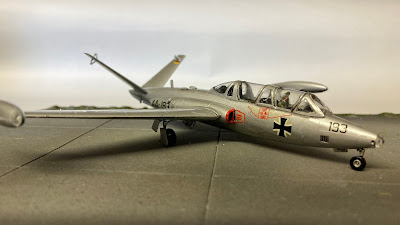Spitfire Squadron … Part 4
It’s finally time to reveal the date of my diorama, a season and year which can be derived from perhaps an unusual source; the RAF vehicle paint scheme and I have to thank Mike Starmer on the Airfix Tribute Forum for this following factoid:
1937 RAF vehicles were officially RAF Blue Grey BS.33
1939-40 vehicles in France and Southern England were painted brown and green as used for building camouflage.
1941 August (AMO 618/41) the RAF fell into line with army’s Khaki Green with Dark Tarmac stripe disrupter.
1942 December (AMO 1397/42) changed to SCC2 Brown with SCC1A British Brown disrupter in a 'Mickey Mouse' design.
1943 October changed the disrupter from SCC1A British Brown to SCC14 Black with the same 'Mickey Mouse' design.
1944 September change to an overall SCC15 Olive Drab paint scheme.
1946 (AMO 306/46), following the end of the war, changed the scheme back to Gloss RAF Blue Grey
As the majority of the RAF vehicles are in the brown and black wavy 'Mickey Mouse' design and none are in Olive Drab it is at least October 1943 and no later than September 1944, and as I opened sating it was between 1941 and 1943 and the trees have autumn leaves, it has to be between October to November 1943!
So, what else is going on this RAF Airfield in Autumn 1943?
Beyond the control tower, there are parked up 3 vehicles. There is no surprise to see an RAF Standard Tilly, but the presence of the two Jeeps is intriguing. |
One is from the British Army 6th Airborne Division and the other the US Army 4th Divisional HQ. The 3 drivers, now deep in conspiratorial conversation, have just delivered their respective military leaders to the control tower, where they they are now being escorted within, to collaborate in vital D-Day planning!
Spitfires, like the fighter‐bomber equipped Mk.Vc in front of the hanger, went on to provide essential air support for the D‐Day landings. Around 55 squadrons of Spitfire participated in the invasion of Normandy, between 5 to 7 June 1944, carrying out ground attack missions; perhaps the most famous occurring after the D-Day landings, was on 17 July 1944 when General Rommel himself was wounded in an attack by a Spitfire fighter.

There was much fear during this period of 5th Columnists and Nazi spies. While in reality, and backed up by Ben Macintyre’s excellent book ‘Agent Zigzag’, these fears were mostly unfounded, however, towards the rear of the airfield, you’ll see a spy cornered by 3 RAF Police officers, who, with the high profile visitors on the base, are taking no chances! In Ben Macintyre’s book, the British double agent Eddie Chapman is dropped into England during early 1943 to blow up the Mosquito factory on the outskirts of London; so there was certainly a desire on the part of Germany to use such spies to disrupt the British war effort.

In October 1941, with the Luftwaffe now concentrating on the Russian front and air raids on Britain lessening, so did the need for anti aircraft defences, however, the presence of senior military leaders on the base also has the Bofors 40mm Anti Aircraft gun and crew, repurposed from a my North African campaign collection, scanning the sky for a surprise Luftwaffe attack.
Finally, did you spot the set of camouflaged De Havilland Vampire wings at the back of the hanger?
I had these left over from a previous build so thought I’d drop them in for fun, as the prototype of this single jet engined DH.100 De Havilland Vampire, Britain’s second jet fighter code named ‘Spider Crab’, conducted its maiden flight from Hatfield Aerodrome on 20 September 1943.
Although it didn’t actually enter service until a few months after the War, it did go on to be adopted as a replacement for many of the wartime piston-engined fighter aircraft, such as the Spitfire.
I hope you’ve enjoyed my take on this post Battle of Britain, pre D-Day airfield, and the backstories to the various scenes.
The End












































